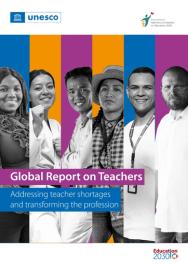Teachers play a key role in shaping the future...
from https://www.unesco.org/en/articles/global-report-teachers-what-you-need-know
News
Global report on teachers: What you need to know

Teacher shortage affect specific regions or income levels?
Teacher shortages are a global issue, prevalent not only in developing nations but also in high-income regions like Europe and North America. Despite well-resourced education systems, these regions struggle to recruit and retain qualified educators, posing significant challenges to educational quality and equity. Notably, attrition rates among primary teachers almost doubled from 4.62 per cent globally in 2015 to 9.06 in 2022, with teachers often leaving the profession within their initial five years. Understanding the widespread nature of this shortage and its socio-economic impacts is crucial in formulating effective, all-encompassing solutions.
How to tackle the teacher shortage effectively?
Addressing teacher shortages requires a holistic approach. Beyond recruitment, factors such as teacher motivation, well-being, retention, training, working conditions, and social status need attention. Creating attractive career pathways with equitable access to professional development, autonomy, and purpose is crucial in sustaining teachers' motivation. Recognizing the multi-faceted nature of this issue and proposing comprehensive strategies is crucial to finding lasting solutions.
Why is promoting gender equality in teaching essential?
Inclusive policies that foster gender equality in the teaching profession are vital. Diverse teaching workforces reflecting the communities they serve enhance the relevance of education and enrich the learning experience. Encouraging women's representation in leadership positions while engaging men in the teaching profession, especially at early years education, is critical. Understanding the significance of a gender-balanced teaching workforce and its impact on educational outcomes is crucial in crafting inclusive and effective education systems.
How can countries address teacher shortages?
Enhancing wages, working conditions, and investing in education significantly impact a teacher's well-being and motivation. Involving teachers in decision-making and fostering a collaborative school culture can attract and retain quality educators. Adequate investment in novice teachers can reduce attrition and address shortages sustainably. Exploring the nuanced details of these measures and their potential impact on the teaching landscape is vital to implement effective reforms.
Why is the shortage of teachers a pressing issue?
The shortage of teachers stands as a major challenge as we approach 2030. The UNESCO-Teacher Task Force’s global report on teachers exposes alarming statistics. This scarcity is not just a number: It is a crisis undermining educational systems globally. The effect of a worldwide teacher shortage is profound, leading to larger class sizes, overburdened educators, educational disparities, and financial strain on educational systems. It is crucial to understand the profound impact this shortage has on educational quality and access.
What much will the financing of new teaching positions cost?
Determining how much to pay current teachers or investing in infrastructure or professionalization initiatives are key financial decisions for any education system. In addition, however, many countries must also factor in projected costs of new teaching positions. According to latest projections, and in order to meet the SDG target 4, the financing of the additional teachers needed will cost US$12.8 billion for universal primary education, and US$106.8 billion for universal secondary education. Combined, additional financing needed to cover new primary and secondary teaching posts’ salaries by 2030 reaches US$120 billion annually.
How can teachers be empowered to transform education positively?
The global teacher shortage demands urgency. It's not solely about quantity but also about the quality of prepared and retained teachers. The Global Report on Teachers aims to offer evidence-informed solutions to ensure every child has access to qualified and motivated teachers. Recasting teaching as a collaborative profession, lifelong professional development, professional autonomy, and engaging teachers in decision-making are crucial aspects highlighted in the report. Delving deeper into the proposed strategies and understanding their transformative potential is essential to reshape the teaching landscape.
This new report will be launched at the Policy Dialogue Forum on addressing global teacher shortages on 26 February 2024 in Johannesburg, South Africa. On this occasion, the UN High-Level Panel on the Teaching Profession, supported by a joint UNESCO-ILO Secretariat, will also release its recommendations on transforming the teaching profession.
What are the alarming findings regarding the shortage of teachers?
The global report on teachers reveals an urgent need for 44 million primary and secondary teachers worldwide by 2030. This includes a demand for seven out of ten teachers at the secondary level and a need to replace over half of the existing teachers leaving the profession. Sub-Saharan Africa is especially affected, with an estimated need for 15 million new teachers by 2030. Understanding the scale of this demand, its geographical implications, and the subsequent effects on educational infrastructure and student-teacher ratios is fundamental to comprehend the gravity of the situation.




No comments:
Post a Comment